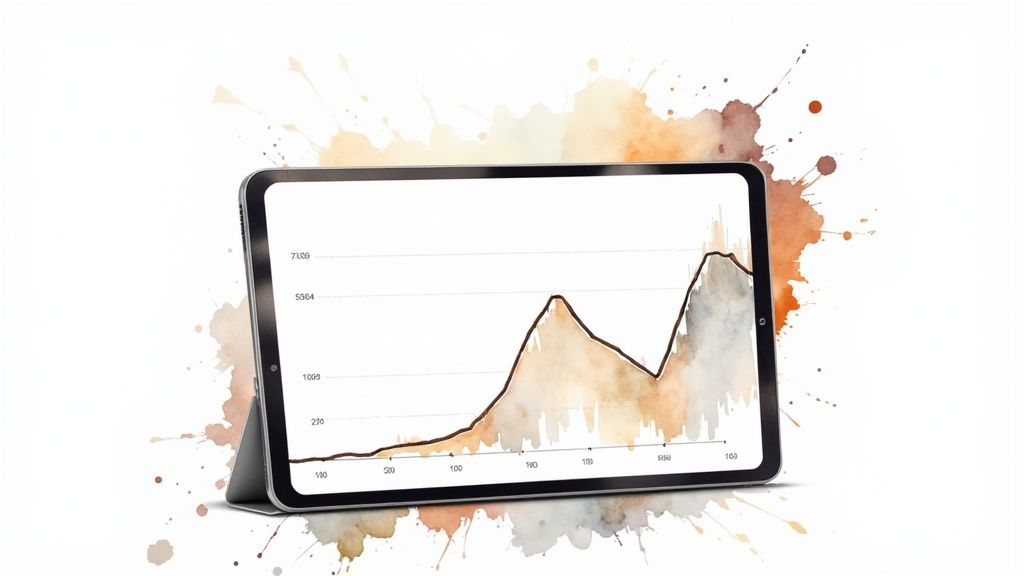




Before delving into the intricacies of altcoin research, it's essential to grasp the complexity of the ecosystem. The altcoin landscape extends beyond simply being "Bitcoin alternatives." This foundational understanding is critical for building a comprehensive research strategy. For instance, evaluating a utility token requires a different approach compared to a security token.
Altcoins comprise a diverse array of digital assets, each possessing unique characteristics and serving distinct purposes. Let's examine some key categories:
Utility Tokens: These tokens grant access to specific products or services within a given blockchain ecosystem, functioning like digital keys to a particular platform.
Security Tokens: Representing ownership in an underlying asset, such as company equity or real estate, these tokens often entail regulatory compliance requirements.
Stablecoins: Designed to maintain price stability, typically pegged to a fiat currency like the US dollar, stablecoins offer refuge from the volatility often characteristic of other cryptocurrencies.
Emerging Categories: The altcoin space is a hotbed of innovation. This includes governance tokens, which confer voting rights within decentralized organizations, and non-fungible tokens (NFTs), representing unique digital items.
This diverse landscape necessitates a nuanced understanding of each asset class. These assets also differ fundamentally from Bitcoin, which primarily serves as a store of value. This distinction significantly impacts research methodologies, requiring a broader lens than mere price chart analysis. For a deeper dive into cryptocurrency market research, see this guide: How to master cryptocurrency market research.
The altcoin market operates within the broader cryptocurrency market, a space characterized by substantial growth and volatility. As of early 2023, the global cryptocurrency market cap stood at approximately $2.73 trillion, with Bitcoin commanding roughly 58.74% market share. The market encompasses over 16,682 cryptocurrencies traded across more than 1,282 exchanges. This expansive landscape presents both opportunities and challenges. For more detailed market statistics, visit CoinGecko.
Understanding the influential forces within the altcoin market is paramount. Key players include:
Developers: The teams behind projects are integral to their success, driving technological development and adoption through their expertise and vision.
Investors: Both retail and institutional investors exert significant influence on market prices and sentiment, their decisions shaping a project's trajectory.
Community: A robust and active community can be a catalyst for growth and adoption.
Exchanges: Trading platforms play a crucial role in liquidity and accessibility of altcoins.
The interplay between these key players significantly influences project outcomes. Effective altcoin research requires analyzing not only the technology itself but also the individuals and organizations involved. Understanding these dynamics provides crucial context for evaluating projects and making informed investment decisions.

Effective altcoin research requires a robust set of tools. Just as a skilled craftsman needs more than a single instrument, successful crypto analysts rely on a diverse toolkit. This section explores key platforms used by experienced researchers, comparing both free and premium solutions. We will also examine how to derive actionable insights from these resources.
Various platforms offer essential data and insights, from market trends to project fundamentals.
Data Aggregators: Websites like CoinMarketCap and CoinGecko provide overviews of market capitalization, price charts, and trading volume. They are excellent starting points for initial screening and comparison of altcoins.
Blockchain Explorers: Tools like Etherscan (for Ethereum-based tokens) and BSCScan (for Binance Smart Chain tokens) allow in-depth analysis of on-chain activity. Researchers can examine transaction history, smart contract code, and token distribution.
Social Sentiment Tools: Platforms such as LunarCrush and Santiment track social media mentions, sentiment analysis, and community engagement. This data helps gauge public opinion and identify potentially trending projects.
These resources are just a starting point. Institutional-grade data is also essential for effective altcoin research. Platforms like CoinDesk Data offer comprehensive insights into more than 10,000 coins and 300,000 trading pairs, providing both historical and real-time data. Key metrics such as volume, open interest, and social stats are available, which are crucial for strategy backtesting, market sentiment analysis, and portfolio valuation. Such data empowers investors to make informed decisions by providing a detailed view of market dynamics and trends.
To assist in choosing the right platform, the table below summarizes the key features of several leading altcoin research platforms.
To help you choose the best research tools, we've compiled a comparison of leading platforms:
Top Altcoin Research Platforms Comparison:
| Platform | Free/Paid | Key Features | Data Coverage | Best For |
|---|---|---|---|---|
| CoinMarketCap | Free | Market cap, price charts, trading volume | Wide range of cryptocurrencies | Beginners, general overview |
| CoinGecko | Free | Market cap, price charts, trading volume, developer activity | Wide range of cryptocurrencies | Beginners, general overview |
| Etherscan | Free | Transaction history, smart contract code, token distribution | Ethereum blockchain | Ethereum-based token research |
| BSCScan | Free | Transaction history, smart contract code, token distribution | Binance Smart Chain | BSC-based token research |
| LunarCrush | Free & Paid | Social media mentions, sentiment analysis, community engagement | Various cryptocurrencies | Social sentiment analysis |
| Santiment | Paid | Social media mentions, sentiment analysis, on-chain data | Various cryptocurrencies | In-depth market analysis |
| CoinDesk Data | Paid | Institutional-grade data, historical and real-time metrics | 10,000+ coins, 300,000+ trading pairs | Professional investors, institutions |
This table provides a concise overview of the available tools, allowing researchers to choose the platforms that best align with their specific needs and research goals.
Beyond market data, a thorough understanding of a project's technical aspects is crucial. This involves examining whitepapers and GitHub repositories.
Whitepapers: A project's whitepaper outlines its goals, underlying technology, and tokenomics. Focus on understanding the problem being addressed, the proposed solution, and the team's credentials.
GitHub Repositories: For those with technical expertise, reviewing a project's GitHub repository provides valuable insights into its development activity. Look for regular updates, a substantial number of contributors, and a well-maintained codebase, which indicate a healthy and active development team.
The most effective research approach is to develop a personalized system tailored to your specific needs and technical expertise.
Start with the Basics: Begin with free resources like data aggregators and social sentiment tools to gain a general market overview.
Gradually Incorporate More Advanced Tools: As your knowledge expands, explore blockchain explorers, whitepapers, and GitHub repositories.
Focus on Your Investment Goals: Align your research with your objectives. Long-term investors should prioritize fundamental analysis, while traders may focus on technical analysis.
Combine Multiple Tools: Use a combination of tools to gain a comprehensive understanding. For instance, combine on-chain data from a blockchain explorer with market sentiment from a social analytics platform.
By developing a structured research process and utilizing the right tools, you can gain a significant advantage in the altcoin market. This approach empowers you to navigate the crypto landscape and make well-informed investment decisions.

Beyond the speculative frenzy surrounding altcoins lies a crucial question: what defines their long-term value? This highlights the importance of fundamental analysis. It’s about evaluating a project’s intrinsic value based on multiple factors, separating viable investments from passing trends.
A critical aspect of fundamental analysis is assessing a project’s tokenomics. This means understanding the token distribution, vesting schedules, and its utility within the ecosystem.
For instance, a project with highly centralized token distribution, where a small group holds a large percentage, is a potential red flag. Such concentration could make the market vulnerable to manipulation.
Conversely, long vesting periods for team tokens often signal long-term commitment, bolstering investor confidence.
Evaluating the team is another key element. While LinkedIn profiles are a starting point, deeper research is crucial. Look for proven experience in relevant fields, successful past projects, and a clear vision.
Investigate the team’s transparency and communication, too. Open communication builds trust and fosters a strong community, a crucial factor in a project’s success.
Analyzing a project’s development activity is essential. A regularly updated GitHub repository signals active development. Look for substantial code contributions and a responsive team addressing community feedback.
Demonstrable progress is a more reliable indicator than marketing hype. Remember, technical proficiency alone is insufficient. Market demand and real-world application are also crucial.
Meaningful community engagement indicates real-world adoption. Analyze social media, forum discussions, and overall sentiment. A vibrant, growing community suggests genuine interest.
Similarly, differentiate meaningful partnerships from marketing ploys. Look for partnerships contributing to the project’s development, adoption, or ecosystem growth. Collaborations with established companies or integration into existing platforms can signal real progress.
The decentralized finance (DeFi) sector, often involving altcoins, has seen substantial growth. Ethereum has been a leader, but other platforms are emerging. Researching altcoins within DeFi involves analyzing their role in lending protocols, decentralized exchanges, and other financial applications. This requires understanding the technology, market demand, scalability, and adoption potential.
A systematic approach to fundamental analysis is crucial for navigating the altcoin landscape. This might involve a checklist of key factors or a weighted scoring system for project comparison.
By combining these techniques, you can go beyond superficial evaluations and gain deeper insights into a project's true potential. This, combined with thorough research and critical thinking, improves your ability to identify promising altcoins and make informed investment decisions.

While fundamental analysis provides a crucial foundation for altcoin research, technical analysis is equally important. However, applying technical analysis to altcoins demands a different approach compared to traditional markets or even Bitcoin. This section explores how effective traders modify technical analysis strategies for these volatile markets.
Unlike Bitcoin, which often sets the tone for broader market trends, altcoins follow their own distinct cycles. These cycles, characterized by periods of rapid growth and subsequent steep declines, are shaped by a range of factors.
These include Bitcoin's price action, overall market sentiment, and individual project developments. Recognizing these cycles is essential for accurately timing entry and exit points. This involves examining historical price data, recognizing patterns, and grasping the relationship between Bitcoin's dominance and altcoin performance.
When researching altcoins, understanding market trends and capitalization is key. For instance, during the "Altcoin Season" of May 2021, the combined market capitalization of the top 100 altcoins reached approximately 130% of Bitcoin's market cap.
This period saw rapid price appreciation, with altcoins frequently outperforming Bitcoin. Large-cap altcoins achieved returns of 174% compared to Bitcoin's 2% between February and May 2021. This demonstrates the potential for substantial gains, but also highlights the critical role of timing and market sentiment in altcoin investments. More detailed statistics can be found here.
Not all technical indicators are equally effective for analyzing altcoins. While traditional indicators like Moving Averages and the Relative Strength Index (RSI) can be helpful, they should be used carefully.
Due to the volatile nature of altcoins, shorter-term moving averages and RSI settings are often more suitable. Furthermore, volume analysis becomes especially important. A spike in trading volume can frequently signal significant price movements, offering valuable confirmation for potential breakouts or breakdowns.
Examining both successful and unsuccessful technical setups is crucial for honing your altcoin research skills. This involves studying historical charts to pinpoint specific signals that preceded significant price shifts.
It also requires understanding why certain setups succeeded while others failed. This practical approach allows you to refine your technical analysis skills and adapt to the specific characteristics of the altcoin market.
Given the rapid price fluctuations common in altcoin markets, setting effective price alerts is essential. This enables you to react swiftly to market changes and seize opportunities as they emerge.
Moreover, configuring your charts to reflect altcoin-specific volatility patterns is crucial. This might involve using logarithmic scales or adjusting timeframes to gain a clearer perspective on price action.
By tailoring your analytical tools to the unique dynamics of altcoins, you can stay ahead of the curve and make more informed trading decisions.
Understanding how to research altcoins involves more than just analyzing price charts and tokenomics. Savvy investors recognize that altcoin performance is intertwined with broader economic and regulatory forces. This section explores how to integrate these macro perspectives into your altcoin research process.
Monetary policy and inflation significantly influence all financial markets, including cryptocurrencies. Rising interest rates, for example, can make holding altcoins less attractive compared to traditional yield-bearing assets like bonds. This can lead to a decrease in demand and potentially lower prices. Conversely, loose monetary policy can sometimes fuel speculative investments, potentially benefiting altcoins. However, the relationship is complex and not always predictable.
High inflation can erode the purchasing power of fiat currencies, potentially driving investors towards alternative assets like altcoins as a hedge. However, different altcoin categories respond differently to these macroeconomic conditions. Stablecoins, pegged to fiat currencies, may see increased demand during periods of high inflation as investors seek to preserve their capital. Conversely, more speculative altcoins might experience higher volatility during such times.
Regulatory changes are a significant factor influencing the altcoin landscape. New regulations can either boost investor confidence by providing clarity and legitimacy or stifle innovation and adoption through restrictive measures. Recognizing early warning signs of regulatory shifts is essential for successful altcoin research.
Announcements of regulatory investigations or crackdowns on specific projects, for instance, can trigger sharp price declines. Conversely, positive regulatory developments, such as approvals for exchange-traded funds (ETFs), can signal growing mainstream acceptance and potentially drive investment. When evaluating altcoins, considering broader economic and technological factors is important. Economic conditions such as GDP growth, exchange rates, and regulatory changes can impact the cryptocurrency market. Technological advancements, like improvements in blockchain scalability and security, can also influence the adoption and value of altcoins. Furthermore, social factors such as consumer interest and demographic trends contribute to market demand and sentiment. Explore this topic further here.
Experienced altcoin researchers also monitor cross-market correlations. This involves tracking the relationship between altcoin performance and other asset classes, like stocks, bonds, and commodities. Understanding these correlations can provide valuable insights into potential market movements.
For example, if altcoins have historically shown a strong positive correlation with tech stocks, a downturn in the tech sector might signal a potential decline in altcoin prices. This awareness enables investors to anticipate market shifts and adjust their portfolios accordingly. Furthermore, tracking sentiment indicators can be beneficial. This involves analyzing social media discussions, news articles, and expert opinions to gauge overall market sentiment towards altcoins. Positive sentiment can suggest increased demand and potentially higher prices, while negative sentiment can signal potential declines.
Developing a systematic approach to integrating these macro perspectives is crucial for informed altcoin research. This involves regularly monitoring economic data, regulatory news, cross-market correlations, and sentiment indicators. Coindive’s features, including customizable alerts on social activity and AI-driven context for price alerts, can assist with this process.
By incorporating these broader market signals into your analysis, you can gain a more nuanced understanding of the factors driving altcoin performance. This allows for more informed investment decisions, helping you navigate the complex and ever-evolving altcoin landscape with greater confidence.
Building a robust research process is essential for navigating the altcoin market. This section outlines a practical framework, guiding you from initial project discovery to informed investment choices.
A weighted scorecard offers an objective method for altcoin evaluation. This system assigns weights to different research criteria based on individual investment strategies and risk tolerance. For instance, long-term investors might prioritize fundamental analysis over short-term technical indicators. A long-term investor might place a heavier emphasis on the project's underlying technology and team, while a short-term trader may prioritize market sentiment and technical analysis.
To help you get started, we've outlined a sample framework below. This can be adapted and modified to fit your specific investment needs and preferences. Remember, the key to a successful scorecard is tailoring it to your own unique circumstances.
This table outlines a potential framework for evaluating different altcoin projects. Remember, the weights assigned to each category should reflect your specific investment priorities.
To illustrate the application of this framework, let’s consider two hypothetical altcoin projects: Project A and Project B.
Project A boasts a strong team with proven experience, innovative technology, and a well-defined tokenomics model. However, it suffers from low community engagement and limited market adoption.
Conversely, Project B benefits from a vibrant and active community, strong partnerships, and considerable market hype. Yet, its underlying technology is less innovative and its team lacks proven experience.
By applying the weighted scorecard, we can objectively compare these two projects despite their differing strengths and weaknesses. The scorecard allows us to quantify our research and make more informed investment decisions.
The table below provides a more detailed look at the criteria used in the scorecard framework. This breakdown helps to further clarify the evaluation process and offers a starting point for constructing your own personalized research tool.
Before diving into the table, it's important to remember that this framework is a starting point. You should adjust the weights and metrics to align with your own specific investment goals.
This framework helps to quantify your research and objectively compare different projects. Adjust the weights and metrics to reflect your unique investment objectives. This personalized approach ensures your research directly supports your individual strategy.
| Evaluation Category | Key Metrics | Weight | Scoring Guide |
|---|---|---|---|
| Team & Experience | Relevant experience, past successes, transparency | 25% | 1-5 (1=Poor, 5=Excellent) |
| Tokenomics | Distribution model, vesting schedule, token utility | 20% | 1-5 (1=Poor, 5=Excellent) |
| Technology & Innovation | Whitepaper strength, GitHub activity, scalability | 20% | 1-5 (1=Poor, 5=Excellent) |
| Community & Adoption | Social engagement, partnerships, market demand | 15% | 1-5 (1=Poor, 5=Excellent) |
| Market Analysis | Trading volume, price trends, market capitalization | 10% | 1-5 (1=Poor, 5=Excellent) |
| Financial Metrics | Liquidity, market depth, trading history | 10% | 1-5 (1=Poor, 5=Excellent) |
This scorecard framework empowers investors to assess altcoin projects based on a range of crucial factors, moving beyond the hype and focusing on tangible metrics.
Even experienced analysts can be influenced by cognitive biases, mental shortcuts that can skew decision-making. Confirmation bias, the tendency to favor information confirming pre-existing beliefs, can cause investors to overlook critical warning signs. Similarly, FOMO (Fear Of Missing Out) can lead to impulsive decisions driven by market hype.
Cultivating self-awareness and actively seeking diverse perspectives are key to mitigating these biases. Challenge your assumptions and critically evaluate all available information. Establishing clear investment rules and adhering to them can help prevent emotional decisions.
Maintaining a detailed record of your research is crucial. A research journal or spreadsheet can track your findings, including evaluation criteria, scoring rationale, and final investment decisions. This creates a valuable archive for future review and analysis.
Establishing feedback loops is equally important for continuous improvement. Regularly review past investment decisions, analyzing both wins and losses. This helps identify weaknesses in your research process and refine your approach over time. Adapting to market changes and learning from past experiences is vital in the dynamic altcoin landscape. Coindive offers tools to help manage this process. Learn more at Coindive.